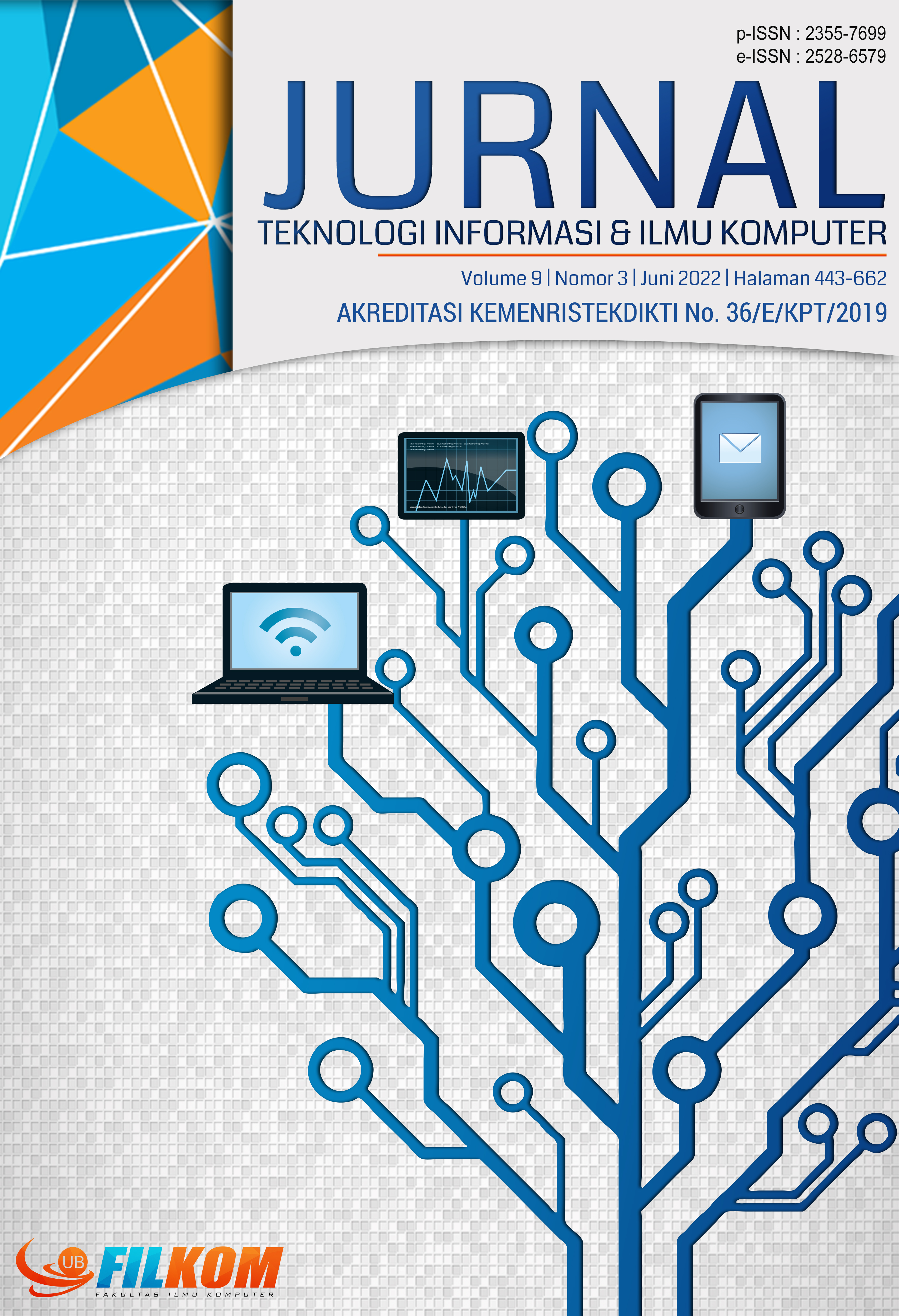Pengembangan Permainan Edukasi Berbasis Augmented Reality untuk Pembelajaran Senyawa Hidrokarbon bagi Siswa Sekolah Menengan Atas (SMA)
DOI:
https://doi.org/10.25126/jtiik.2022935743Abstrak
Kimia merupakan satu dari banyak cabang ilmu pengetahuan yang diajarkan pada Sekolah Menengah Atas (SMA), akan tetapi hasil observasi tenaga pengajar mengatakan bahwa masih banyak siswa yang sulit untuk mempelajari konsep kimia yang cenderung abstrak. Contoh materi yang masih membuat siswa bingung adalah materi senyawa hidrokarbon. Untuk mengatasi permasalahan dari konsep kimia yang abstrak, penelitian ini memiliki tujuan untuk mengembangkan media pembelajaran yang menarik melalui gim edukasi untuk mempelajari struktur serta tata penamaan The International Union of Pure and Applied Chemistry (IUPAC) senyawa hidrokarbon dengan menggunakan Augmented Reality (AR). Gim edukasi yang akan dikembangkan memiliki genre puzzle penyusunan senyawa yang dapat dilihat dengan menggunakan AR. Gim juga akan mendeteksi nama dari senyawa yang dibuat oleh pemain. Penelitian akan dilakukan dengan menggunakan metode Iterative and Rapid Prototyping, serta hasil dari penelitian akan diuji secara fungsional menggunakan Black Box Testing dan diujikan kepada responden dengan modul Game Experience Questionnaire (GEQ). Pada GEQ responden akan diberikan 2 modul yang dijawab saat sedang bermain gim dan setelah bermain gim. Hasil dari pengujian fungsional menunjukkan bahwa gim bekerja dengan baik dengan 100% validitas, begitu juga hasil pengujian pengalaman pemain dengan GEQ. Berdasarkan kuesioner dengan GEQ, gim yang menggunakan AR dapat menambah minat dan mengurangi rasa bosan siswa saat belajar.
Abstract
Chemistry is one of the many branches of science that is taught on high school, but observations from teachers shows that there’s still many students who struggles learning chemistry because of its abstract and intangible concept. Example of a chapter that student still struggles is hydrocarbon chapter. To help with the problem of the abstractness concept of chemistry, this study has a goal to develop an educational game as a learning media to study about the structural molecule of hydrocarbon compound and its The International Union of Pure and Applied Chemistry (IUPAC) nomenclature using Augmented Reality (AR). The game will be developed as a puzzle game, on which the player arrange and build a hydrocarbon compound that can be seen on the real world with AR. The game will also detects the compound’s name. This study will be done with Iterative Rapid Prototyping design cycle. The study’s functionality result will be tested with Black Box Testing and tested on students with Game Experience Questionnaire (GEQ) module to asses the student’s experience. There is 2 modules, which will be asked when the respondent play the game, and when they’re finished playing the game accordingly. The results of functionality testing shows that the game works well with 100% validity, just as the experience testing with GEQ. Based on the questionnaire results, game that uses AR could improve the student’s interest and help them to overcome their feeling of boredom in learning.
Downloads
Referensi
BOLETSIS, C., & MCCALLUM, S., 2013. The Table Mystery: An Augmented Reality Collaborative Game for Chemistry Education. Serious Games Development and Applications: 4th International Conference. Trondheim, Norway, 25-27 September 2013. Norway: Gjøvik University College.
DILEEPA, D. 2021. Branches of Science – The Complete List [2021 Update]. In Science Mirror.
https://www.sciencemirror.com/branches-of-science-the-complete-list
EKO SETYOWATI, W. A., SUMADI, C., & MULYANI, S. 2015. Pengembangan Media Game Senyawa Hidrokarbon Pada Pembelajaran Kimia Di Sma Batik 1 Surakarta Dan Sma Batik 2 Surakarta. Jurnal Pendidikan Kimia Universitas Sebelas Maret, 4(2), 82–88.
HENSTAM, P. 2018. How many participants are needed when usability testing physical products? https://pdfs.semanticscholar.org/f3e0/4ec8985b898f5bb591f858ae1384933d0c96.pdf
KAUFMANN, H., & SCHMALSTIEG, D. 2003. Mathematics And Geometry Education With Collaborative Augmented Reality. 23(5), 517–521. https://doi.org/10.1002/micr.10163
Kementerian Pendidikan & Kebudayaan (Kemdikbud), 2020. Silabus Terbaru Revisi 2020 Kimia Kelas 11.
Jakarta: 2020 [online] Tersedia melalui:
Penyedia < https://guruberbagi.kemdikbud.go.id/rpp/silabus-terbaru-revisi-2020-kimia-kelas-11> [Diakses 21 September 2020]
LIKERT, R. 1932. Technique for the Measurement of Attitudes. ARCHIVES OF PSYCHOLOGY. https://doi.org/10.4135/9781412961288.n454
MARKLUND, B. B., BACKLUND, P., & ENGSTROM, H. 2014. The practicalities of educational games: Challenges of taking games into formal educational settings. 2014 6th International Conference on Games and Virtual Worlds for Serious Applications, VS-GAMES 2014. https://doi.org/10.1109/VS-Games.2014.7012170
NOEMÍ, P.-M., & MÁXIMO, S. H. 2014. Educational Games for Learning. Universal Journal of Educational Research, 2(3), 230–238. https://doi.org/10.13189/ujer.2014.020305
POELS, K., DE KORT, Y. A. W., & IJSSELSTEIJN, W. A., 2007. D3.3 : Game Experience Questionnaire: developmentof a self-report measure to assess the psychological impact of digital games. Technische Universiteit Eindhoven.
SCHREIBER, I., 2009. Level 2: Game Design / Iteration and Rapid Prototyping. [online] Game Design Concepts.
SIRHAN, G. 2007. Learning Difficulties in Chemistry: An Overview. Journal of Turkish Science Education, 4(2), 2–20.
SUNYONO WIRYA, I. W., SUYANTO2, E., & SUYAD, G. 2009. Identifikasi Masalah Kesulitan dalam Pembelajaran Kimia SMA Kelas X di Propinsi Lampung. Journal Pendidikan MIPA (JPMIPA), 10(2), 9–18.
TAÇGIN, Z., ULUÇAY, N., & ÖZÜAĞ, E., 2016. Designing and Developing an Augmented Reality Application: A Sample Of Chemistry Education. JOTCSC, Volume 1, Ed 1.Pp.147-164.
WU, H. K., LEE, S. W. Y., CHANG, H. Y., & LIANG, J. C. 2013. Current status, opportunities and challenges of augmented reality in education. Computers and Education, 62, 41–49. https://doi.org/10.1016/j.compedu.2012.10.024
Unduhan
Diterbitkan
Terbitan
Bagian
Lisensi

Artikel ini berlisensi Creative Common Attribution-ShareAlike 4.0 International (CC BY-SA 4.0)
Penulis yang menerbitkan di jurnal ini menyetujui ketentuan berikut:
- Penulis menyimpan hak cipta dan memberikan jurnal hak penerbitan pertama naskah secara simultan dengan lisensi di bawah Creative Common Attribution-ShareAlike 4.0 International (CC BY-SA 4.0) yang mengizinkan orang lain untuk berbagi pekerjaan dengan sebuah pernyataan kepenulisan pekerjaan dan penerbitan awal di jurnal ini.
- Penulis bisa memasukkan ke dalam penyusunan kontraktual tambahan terpisah untuk distribusi non ekslusif versi kaya terbitan jurnal (contoh: mempostingnya ke repositori institusional atau menerbitkannya dalam sebuah buku), dengan pengakuan penerbitan awalnya di jurnal ini.
- Penulis diizinkan dan didorong untuk mem-posting karya mereka online (contoh: di repositori institusional atau di website mereka) sebelum dan selama proses penyerahan, karena dapat mengarahkan ke pertukaran produktif, seperti halnya sitiran yang lebih awal dan lebih hebat dari karya yang diterbitkan. (Lihat Efek Akses Terbuka).















